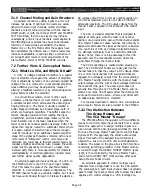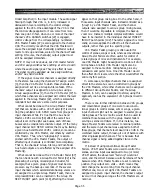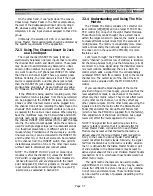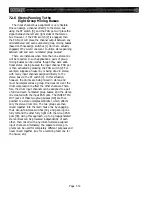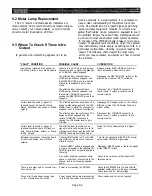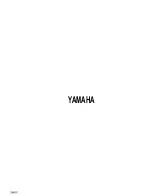
7.2.6 Stereo Panning To the
Eight Group Mixing Busses
The input channel bus assignment is very flexible.
One can assign a channel directly to the stereo bus
using the ST switch [3], and the PAN pot will place the
signal between the left and right sides of that stereo
bus. However, if the PAN switch [2] is engaged, then
the PAN pot will place the channel output between any
odd-numbered and even-numbered group mixing busses
(based on those assign switches [1] which are actually
engaged). Why would one want to utilize stereo panning
between odd and even numbered group busses?
There are instances when more than one stereo mix
will be required. In such applications, pairs of group
mixing busses can be used as though they were addi-
tional stereo mixing busses; the input channel PAN pot
is then activated by pressing the PAN switch [2]. For
example, suppose a house mix is being done in stereo,
with many input channels assigned directly to the
stereo bus via the ST switch [3]. In this situation,
however, the drums are being mixed in stereo, and
must be compressed as a group. One does not want the
drum compression to affect the other channels. There-
fore, the drum input channels can be assigned to a pair
of odd and even numbered group busses, and the stereo
mix created with the input PAN pots. The INSERT IN/
OUT jacks of those two group busses [118] are then
patched to a stereo compressor/limiter, which affects
only the stereo drum mix. The two groups are then
mixed together into the main house mix by engaging
their Group-To-Stereo switches [40], and panning one
fully left and the other fully right with the Group PAN
pots [39]. Using this approach, up to 4 group-generated
stereo mixes can be processed independently of each
other, then mixed with any direct-to-stereo assigned
input channels. Alternately, the separate stereo pro-
grams can be used for completely different purposes and
never mixed together (one for a recording feed, one for
the house, etc.)
Page 7-12
Summary of Contents for PM4000
Page 1: ...PROFESSIONAL AUDIO MIXING CONSOLE PM4000 OPERATING MANUAL YAMAHA ...
Page 2: ...PM4000 OPERATING MANUAL ...
Page 7: ...Section 1 Introduction ...
Page 11: ...Section 2 Brief Operating Instruction ...
Page 47: ...Section 3 Specifications ...
Page 51: ...Dimensional Drawings PM4000 Console all versions Page 3 4 ...
Page 52: ...Page 3 5 ...
Page 53: ...Page 3 6 PM4000 Console Rear Profiles ...
Page 54: ...Module Block Diagrams See back of the manual for overall system block diagram Page 3 7 ...
Page 55: ...Page 3 8 ...
Page 56: ...Page 3 9 ...
Page 57: ...Page 3 10 ...
Page 58: ...Page 3 11 ...
Page 59: ...Page 3 12 ...
Page 60: ...Section 4 Installation Notes ...
Page 72: ...Figure 4 13 Cables For Use With Balanced Sources Page 4 12 ...
Page 79: ...SECTION 5 Gain Structure and Levels ...
Page 82: ...Figure 5 1 Dynamic Range and Headroom in Sound Systems Page 5 3 ...
Page 86: ...Section 6 Optional Functions ...
Page 106: ...Section 7 Operating Notes and Hints ...
Page 119: ...Section 8 Applications ...
Page 127: ...Section 9 Maintenance ...
Page 131: ......
Page 132: ...YAMAHA VN02300 ...







